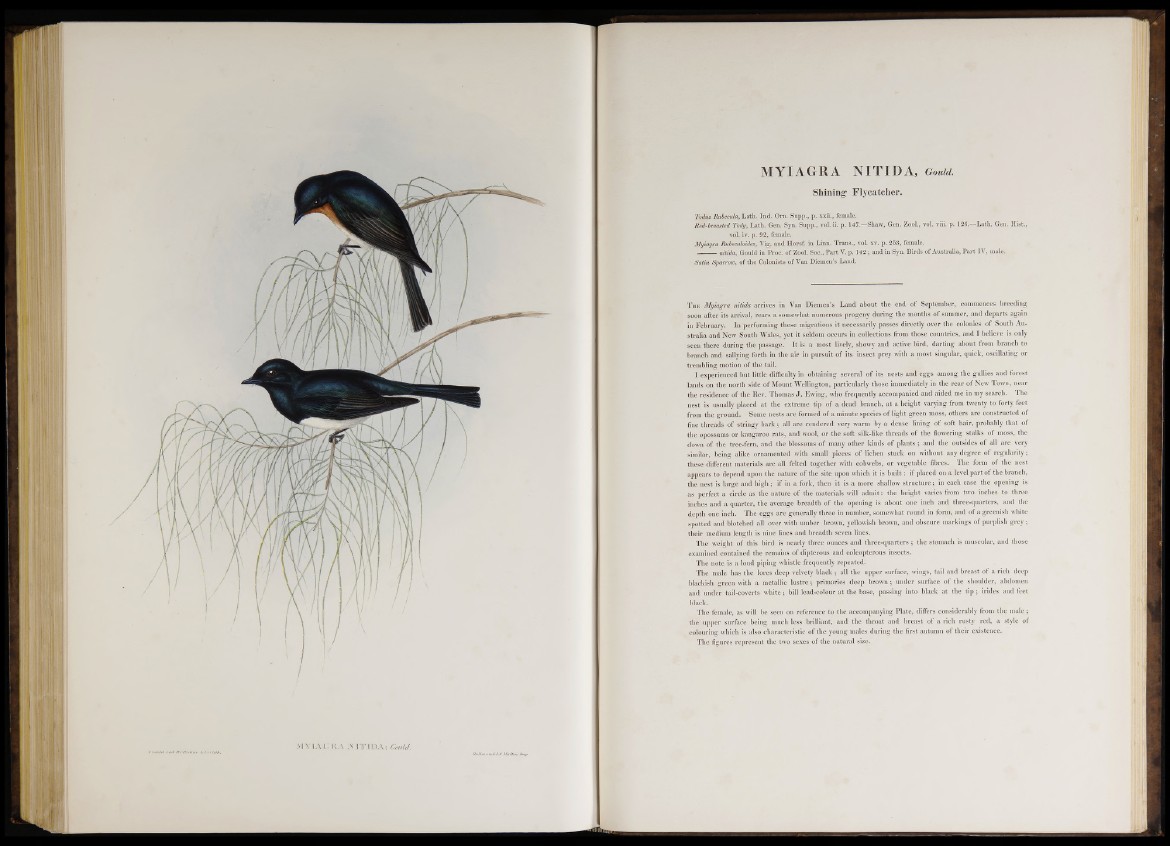
MYIAGRA NITIDA, Gould.
Shining’ Flycatcher.
Todus Rubecula, Lath. Ind. Om. Supp., p. xxii., female.
Red-breasted Tody, Lath. Gen. Syn. Supp., vol.ii. p. 147—Shaw, Gen. Zool., vol. viii. p. 126.—Lath. Gen. Hist.,
vol. iv. p. 92, female.
Myiagra Rubeculoides, Vig. and Horsf. in Linn. Trans., vol. xv. p. 253, female.
nitida, Gould in Proc. of Zool. Soc., Part Y. p. 142 ; and in Syn. Birds of Australia, Part IV, male.
Satin Sparrow, of the Colonists of Van Diemen’s Land.
T h e Myiagra nitida arrives in Van Diemen’s Land about the end o f September, commences breeding
soon after its arrival, rears a somewhat numerous progeny during the months of summer, and departs again
in February. In performing these migrations it necessarily passes directly over the colonies o f South Australia
and New South Wales, yet it seldom occurs in collections from those countries, and I believe is only
seen there during the passage. It is a most lively, showy and active bird, darting about from branch to
branch and sallying forth in the air in pursuit o f its insect prey with a most singular, quick, oscillating or
trembling motion o f the tail.
I experienced but little difficulty in obtaining several o f its nests and eggs among the gullies and forest
lands on the north side of Mount Wellington, particularly those immediately in the rear o f New Town, near
the residence of the Rev. Thomas J . Ewing, who frequently accompanied and aided me in my search. The
nest is usually placed at the extreme tip o f a dead branch, at a height varying from twenty to forty feet
from the ground. Some nests are formed of a minute species o f light green moss, others are constructed of
fine threads of stringy bark; all are rendered very warm by a dense lining o f soft hair, probably that of
the opossums or kangaroo rats, and wool, or the soft silk-like threads o f the flowering stalks o f moss, the
down o f the tree-fern, and the blossoms o f many other kinds o f plants; and the outsides o f all are very
similar, being alike ornamented with small pieces of lichen stuck on without any degree of regularity;
these different materials are all felted together with cobwebs, or vegetable fibres. The form of the nest
appears to depend upon the nature o f the site upon which it is built: if placed on a level part of the branch,
the nest is large and high; if in a fork, then it is a more shallow structure; in each case the opening is
as perfect a circle as the nature of the materials will admit: the height varies from two inches to three
inches and a quarter, the average breadth of the opening is about one inch and three-quarters, and the
depth one inch. The eggs are generally three in number, somewhat round in form, and o f a greenish white
spotted and blotched all over with umber brown, yellowish brown, and obscure markings o f purplish grey ;
their medium length is nine lines and breadth seven lines.
The weight of this bird is nearly three ounces and three-quarters ; the stomach is muscular, and those
examined contained the remains o f dipterous and coleopterous insects.
The note is a loud piping whistle frequently repeated.
The male has the lores deep velvety black ; all the upper surface, wings, tail and breast o f a rich deep
blackish green with a metallic lustre; primaries deep brown; under surface o f the shoulder, abdomen
and under tail-coverts white; bill lead-colour at the base, passing into black at the t ip ; irides and feet
black.
The female, as will be seen on reference to the accompanying Plate, differs considerably from the male;
the upper surface being much less brilliant, and the throat and breast o f a rich rusty red, a style of
colouring which is also characteristic o f the young males during the first autumn of their existence.
The figures represent the two sexes of the natural size.